Our environment is changing rapidly, together with suppliers and partners we are moving step by step towards network cooperation. But how do you act as a principal in a network cooperation? A cooperation in which information flows no longer all go through you as the client, but you want to promote the mutual exchange of information between suppliers and partners. By moving towards network cooperation, transaction costs decrease, trust increases and the degree of ownership increases. How your organization can give substance to the principalship in such a collaboration can be read in this insight.
As the client, you choose suppliers who can best serve the goals of the organization. They should fit the strategy the company has in mind. The supplier’s own interests and interdependencies are not always taken into account. How do you ensure that suppliers are assertive so that you as the client have to perform minimal coordination while not compromising lead time, money and quality? The model in which you as client are the central point of all information is outdated and in many cases no longer seems to work because of the rapid flow of successive decisions that must be made. Working in a network collaboration offers many solutions and is thus the future in how to work with suppliers or partners, each from his own expertise, with a common goal. We explain how such a thing works using a real-life example.

Figure 1- Traditional commissioning

Figure 2- Networking
One project team to foster collaboration
The majority of projects where Supply Value acts as project manager involve suppliers or partners. Consequently, there is a lot of investment in collaboration, at all levels. In the example raised here, this was also very important, as different parties were very dependent on each other to deliver a good product. For this reason, a single project team was created. The example concerns a project in which an IT application is being built together with suppliers. Work is done according to Prince2/Agile method which means that the operational process is carried out by a scrum team. The project leader, in consultation with the product owner, manages the scrum team and reports to the steering committee. So the transition from Agile to Prince2 sits with the product owner and the project leader. To encourage optimal collaboration between suppliers, a number of things are set up at the operational level:
- Everyone who contributes to the final product is on the scrum team. So the scrum team consists of employees from the client’s organization, as well as employees from the various vendors. Everyone is expected to know the Agile way of working.
- An Agile coach trains the team in scrum and assists the scrum master in fostering collaboration within the team. The Agile coach also advises on the role of the scrum team within the rest of the organization, which is not structured Agile.
- Vendors should give each other feedback on how they work and how to work more efficiently and effectively as a team.
- A Proof of Concept is performed before complex parts are built in which there is no experience. In this way, bottlenecks can be quickly identified and resolved before the component is built.
- The scrum team should jointly present and discuss risks. So even if risks are identified at another supplier.
This way of working between suppliers requires trust and good mutual understanding, which ultimately leads to minimal client coordination and low transaction costs. A lot of energy was therefore put into conducting a good retrospective by a good scrum master. It is nice to see that the team became more mature each sprint and therefore more and more energized.
Attention to the project at all levels
To be resistant even when things go wrong in the project, care has been taken to ensure that cooperation at all levels is well established. In addition to the operational cooperation as just explained, tactical and operational levels have been merged at key moments. This means, for example, that all project managers from all suppliers are involved at the project start, so that they know each other and can call each other to account when necessary. In addition, architects (both from client and suppliers) and business analyst are involved in refinements and sprint planning so that there are no surprises during the sprint. By bringing together business analysts and architects from all parties, it is possible to identify at the outset where difficulties may arise. These are then presented to the project manager as risks.
Setting up these structures is not the only thing needed, because how to prevent that when the project threatens to fail to deliver, suppliers do not fall back on their contract and cover themselves that they have delivered what was requested? After all, you as the client want a working product, rather than a contract that is neatly delivered to the letter. For this reason, a strategic consultation has also been set up in which the director of commissioning organization invites the directors of the suppliers. These consultations address how the organizations deal with each other when setbacks may occur. Do we work together in the traditional way and does everyone address the client individually? Or do we call each other first, in order to find a solution among ourselves? In that case, a true network cooperation is set up.

Figure 3- Collaboration at all levels
Withstanding setbacks through collaboration
By setting up the project organization and consultation structure in the way just described, the project was able to withstand major setbacks. And there certainly were. For example, it happened that suppliers expected each other to deliver certain parts of the product. When this turned out not to be the case a couple of times, the suppliers and the client always sought cooperation in order to find a solution. This also meant that in some cases a supplier came up with a possible solution, which also allowed them to profit commercially. In this way, everyone was satisfied and the project was prevented from becoming rudderless or being pointed at each other.
Good principalship
Good procurement, in this case, is investing in your suppliers by investing time in working with other suppliers and employees of the commissioning organization. This way, suppliers also get to know each other and a true network collaboration is created. They can learn together from their cooperation and deploy this to other customers, this way their commercial interest is also nurtured. By discussing the inconveniences in such a cooperation openly and transparently, you create trust and suppliers will also go the extra mile when the going gets tough.
It is not easy to help each other when things go wrong, or threaten to go wrong, instead of securing one’s own part. Supply Value has learned that it can be done and that it brings many benefits at all levels and, above all, saves time and money.
Want to learn more about best practices in network collaboration and good procurement practices? Then contact us or make a no-obligation appointment with one of our experts. You can downlaod the customer case below.


